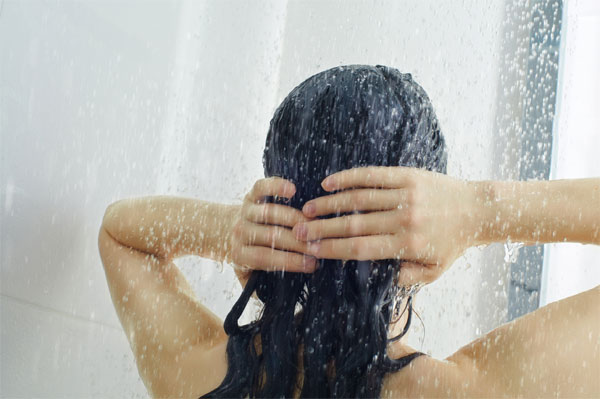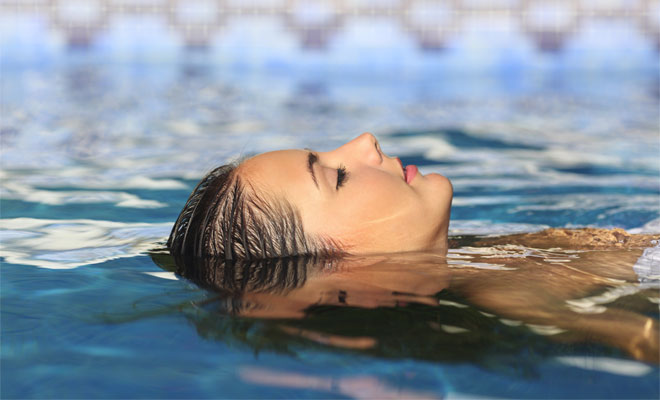Summer is back! The temperatures are quite high and all you can think of having a smooth, cooling swim.
How about joining your friends for an afternoon out at the beach?
After all, it is on a Sunday and about time to start having fun.
However, it is also about time to realize that there are limitations that come with having a little fun.
The fantasy is quite real and achievable, but your hair and its care come first.
Well, don’t make that face.
The fun and summer adventures will still go on, after protecting your colored hair against the effects of excess chlorine[1] in swimming water at the pool, severe and harsh salts at the ocean.
Here are some tips to aid you out in the process.
1. Chlorine And Its Effects On Your Hair

Chlorine And Its Effects On Your Hair – Image/Shutterstock
Chlorine is one of the most effective bleaching agents available in the entire world.
Therefore, your colored hair is at great risk if continuously exposed to chlorine.
Swimming does exactly that and without protective gear or measures, you might end up with dull, brittle, and easily damaged hair.
These are just some of the effects of chlorine on colored hair.
In addition, the hair will lose its texture, your hair will become lighter in color shade and lose its gloss and shine making you appear haggard and in some cases older.
2. Wet Hair Before Diving In

Wet Hair Before Diving In – Image/Shutterstock
It is advisable to always wet or soak your hair in water first before diving into the pool.
Well, you may be asking how to protect colored hair from chlorine by doing this.
Well, this is one of the best-colored hair care tips given for those who love swimming.
It not only keeps your swimming pool clean, but it also prevents chlorination of your hair in the extreme.
Therefore, less chlorine is absorbed by your hair.
3. Wear Hair Oil Before

Wear Hair Oil Before – Image/Shutterstock
Protect the hair from chlorine effects on colored hair.
Hair moisturizes the hair strands and protects them from absorbing chlorine.
In addition, it is one of the ways that you learn to protect your hair from chlorine when swimming.
This is because it forms a protective barrier on the hair making it more slippery preventing further absorption.
4. Invest In a Good SPF

Invest In a Good SPF – Image/Shutterstock
With the onset of summer, sunscreen is always part of your bag essentials.
Ensure that you follow some of the colored hair care tips from chlorine being advertised today.
Be sure to use some of those homemade hair care materials as well as the desired purchase of hair cosmetics and products as they are the best way to protect colored hair from chlorine.
Furthermore, it is an effective hair hack to practice on your colored hair and keep it protected from chlorine effects.
5. Treat After Swimming

Treat After Swimming – Image/Shutterstock
How do I keep my hair color from washing out is another essential question to ask yourself each time you go swimming.
Treating your hair immediately after having your swim is a colored hair care routine that should retain your summer hair colors glow and shine within a short while.
Furthermore, it will protect from the excessive effects of chlorine on colored hair.
6. Invest In Chlorine Removal Hair Products

Chlorine Removal Hair Products – Image/Shutterstock
Well, after every enjoyable swim, ask yourself, does chlorine damage hair color?
The answer is a simple yes. The best way to protect your colored hair from chlorine after a satisfying swim is your next thought.
Well, the first of the colored hair care tips given is to invest in advanced chlorine removal hair products.
They are quite effective in eliminating chlorine from your hair, keeping it protected and safe from its effects.
7. Swimming Cap

Swimming Cap – Image/Shutterstock
Always wear protective swimming caps when having a swim.
These are sometimes uncomfortable and we really love the free-hanging and penetration of beach water into the skin and the scalp.
It is soothing and relaxing.
However, it is a poor colored hair care routine as it exposes your hair to the chlorine in the water and may lead to brittleness and loss of hair shine or smoothness.
Learn how to protect hair from chlorine when swimming.
8. Wash Immediately After Swimming

Wash Immediately After Swimming – Image/Shutterstock
Colored hair care tips from chlorine, strongly advise washing colored hair immediately after having a swim.
Chlorine and excessive sea salts tend to cling on to your hair strands, weakening them by the moment and bleaching out your celebrity-inspired hair highlights and colors.
The highlights and hair colors tend to fade and become a damaged shade of the real brown or dark warm hair color you had worn previously.
Therefore, washing is an essential way and the best way to protect colored hair from chlorine.
9. Wear Conditioner Before And After

Wear Conditioner Before And After – Image/Shutterstock
Conditioning your hair before having the swim prepares it for the harsh chemicals it is about to come into contact with.
It is one of the solutions in eliminating the effects of chlorine on colored hair.
In addition, it protects your hair whenever going for a swim ensuring that your hair strands do not collect and retain the salts and the chlorine in large amounts.
Conditioning afterward is also advised in how to protect your colored hair from chlorine.
You can also wear a conditioning mask and continuously moisturize your hair while protecting it from chlorine effects.
However, it should be given ample and adequate time to cook and ensure total rehydration of the hair.
10. Wear Your Hair Up

Wear Your Hair Up – Image/Shutterstock
It feels free and highly adventurous to let go of your hair when having a swim.
This, however, exposes your hair not only to the sun but also to the excess chlorine in the water.
Learning the best-colored hair care routine in summer or the best-colored hair care tips to practice each time you go out is the best way to limit the chlorine effects on colored hair.
In addition, free hair fall weakens at the roots due to the pressure and strain of moving along with you.
Holding it up high like in a ponytail ensures that the effects of chlorine on colored hair are minimal.
Learn tips of protecting hair from chlorine when swimming before going ahead and enjoying your summer at the beach or in the increasingly highly chlorinated swimming pool water.
FAQ’s:
Que: How to protect blonde hair from chlorine?
Ans: Following Are The ways to protect your hair from chlorine
- Shower before you get in the pool.
- Coat your hair in coconut oil – or olive oil.
- Use a clarifying shampoo.
- Use a leave-in treatment regularly.
- Wash your hair right after getting out of the pool.
- Wear a swimming cap.
Que: How can I protect my hair from chlorine without a swim cap?
Ans: If you can not find a swim cap, then wear your hair in a ponytail or braid to minimize contact with chemicals in the water.
Que: Does coconut oil protect hair from chlorine?
Ans: Coconut oil will reinforce hair’s natural protective barrier while adding moisture to hair.
Like this post? There’s more. Get tons of beauty tips, tutorials, and news on the thebeautyinsiders Facebook & Twitter page. Like us on Facebook – we’ll see you there!

 By Wendy Gould
By Wendy Gould






